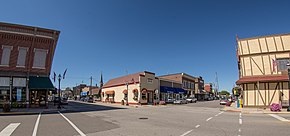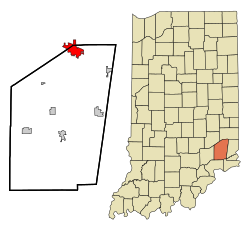Batesville, Indiana
| Batesville, Indiana | |
|---|---|
| City | |
 |
|
 Location in the state of Indiana |
|
| Coordinates: 39°17′54″N 85°13′17″W / 39.29833°N 85.22139°WCoordinates: 39°17′54″N 85°13′17″W / 39.29833°N 85.22139°W | |
| Country | United States |
| State | Indiana |
| Counties | Ripley, Franklin |
| Government | |
| • Mayor | Mike Bettice (R) |
| Area | |
| • Total | 6.16 sq mi (15.95 km2) |
| • Land | 6.09 sq mi (15.77 km2) |
| • Water | 0.07 sq mi (0.18 km2) |
| Elevation | 971 ft (296 m) |
| Population (2010) | |
| • Total | 6,520 |
| • Estimate (2012) | 6,497 |
| • Density | 1,070.6/sq mi (413.4/km2) |
| Time zone | EST (UTC-5) |
| • Summer (DST) | EDT (UTC-4) |
| ZIP code | 47006 |
| Area code(s) | 812 |
| FIPS code | 18-03664 |
| GNIS feature ID | 430573 |
| Website | www |
Batesville is a city in Franklin and Ripley counties in the U.S. state of Indiana. The population was 6,520 at the 2010 census. Both the Batesville Casket Company and the Hill-Rom hospital bed manufacturer are headquartered in this town. Batesville is noted for its central location between Indianapolis, Cincinnati, and Louisville.
Central Batesville Historic District was listed on the National Register of Historic Places in 2011.
Batesville was founded by George H. Dunn, owner of the John Callahan Trust Company. The company bought land and created new towns along rail lines that it began since Dunn was president of the Cincinnati and Indianapolis Railroad. Joshua Bates, who platted the town of Batesville, is thought to be the source of the name. On November 1, 1853, the first train from Cincinnati to Indianapolis passed through Batesville.
Once the railway opened, Dunn and Bates constructed more buildings. George Sims laid out Batesville's first addition in 1858. The following year, German immigrant Henry Boehringer became Batesville's first major builder. A three-story building with a basement on East Pearl Street (formerly known as Broadway Street) became known as the Boehringer Hall because of the dance floor on the third story. The Catholic congregation used the basement before they had built their church.
Between 1860 and 1870, Boehringer built a row of apartments and homes on the north side of Batesville on Boehringer Street. Along with building the apartments and housing, Boehringer purchased the property lot where the Ward School now stands. In 1863 Conrad Rapp purchased numerous property lots on east Broadway Street and bought Louis Walter's gristmill. Louis Walter was the first miller in Batesville and had owned the mill since 1858. In 1865, John F. Brinkman built the Sherman House as a hotel. The building was named after General William Tecumseh Sherman, who had won the final victory for the Union Army in his "march to the sea".
...
Wikipedia
